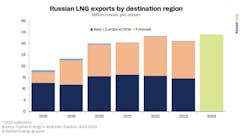Sam Fletcher
OGJ Senior Writer
A four-session natural gas rally from a 7-year low culminated with a 15% jump past $3/MMbtu Sept. 10—the largest 1-day gain in almost 5 years in the New York market. The October contract closed at $3.26/MMbtu, up 42.7¢ for the day on top of an earlier 35% surge through the three previous sessions.
In Houston, analysts at Raymond James & Associates Inc. reported, “While most economic indicators are pointing towards a quicker-than-expected rebound from the recession (and consequential snap-back in industrial demand), with 8 weeks left in the injection season and [US gas] storage levels already at 3.4 tcf, a record high for this time of year, it is hard to see the move as anything other than a technical rally.”
In New Orleans, analysts at Pritchard Capital Partners LLC said, “The gain was driven by short covering as shorts came to the realization that natural gas makes a seasonal low in September and tends to rally through the winter months.” Another “bullish indicator” is that in the first and second quarters, “89% and 96% [respectively] of all wells drilled were completed vs. an average of 85% the previous six quarters; we believe that the inventory of drilled but not completed wells is relatively insignificant at this time and the 1,900 uncompleted well inventory from fourth quarter 2008 has declined significantly,” they said.
Adam Sieminski, chief energy economist, Deutsche Bank, Washington, DC, said, “At the current rate of increase, we believe [gas] storage is nearly certain to exceed the all-time high of 3.565 tcf reached in late October 2007.” As a result, he said, “The strong rebound in US natural gas prices this week will be therefore be difficult to sustain.”
Sure enough, the rally ended Sept. 11 when the contract dropped to $2.96/MMbtu, perhaps marking the end of buying to cover short positions, Pritchard Capital Partners said. However, they said, “Meaningful declines in natural gas supply from reduced production and higher demand should cause natural gas prices to spike in the first quarter of 2010.” Gas prices were up in early trading Sept. 14.
CFTC changes
The US Commodity Futures Trading Commission’s plan to divide investors into “more precise” categories to improve transparency in the commodities market includes “some flaws that could lead to wrong trading conclusions if the data is not properly analyzed,” said Olivier Jakob at Petromatrix, Zug, Switzerland.
CFTC’s “Disaggregated Commitment of Traders” report covers 22 different commodities, “but not all of them,” Jakob warned. The CFTC plans to extend coverage to more commodities in the coming months. “But energy traders need to consider that the new report while it covers the InterContinental Exchange's West Texas Intermediate [positions] does not cover the WTI financial futures,” he said.
On Sept. 8, Jakob said, “Large speculators are net short 24,813 WTI financial contracts so excluding them from the new report will overestimate the net length and price impact of large speculators.”
Likewise, he said, the report does not cover the natural gas swaps-on-futures. “Large speculators are net short in natural gas futures but net long in natural swaps-on-futures; hence the…report will overestimate the net short of large speculators in natural gas.”
The “main interest” of the report is that it breaks down what was previously the “old commercial” category into producer, merchant, processor, and user—“a category that uses futures to hedge their commercial activities (and that we will qualify as real ‘commercial’ and ‘dealers’ that use futures to hedge swaps exposure) (i.e. the provider of a commodity index but as well a bank offering hedging through swaps to a commercial entity),” Jakob said.
However, he said, “The ‘old noncommercial’ category (what we call the large speculators) is split between ‘money managers’ (defined as commodity trading advisors, commodity pool operators, and hedge funds identified by the CFTC regardless if they are registered) and ‘other reportables,’ a category that includes other nonidentified speculators.” Jacob said, “This means that true hedge funds are likely to find their positions mixed between the money managers and the other reportables. We can not read much in that split (i.e. money managers are net long and other reportables are net short in WTI), and we think that the old aggregated numbers for the large speculators leads to a better read of the financial flows.”
Therefore, Jakob said, the Petromatrix analysis of the disaggregated report will merge the money managers and other reportables into one large speculator category “until the CFTC can provide a better definition of other reportables.”
(Online Sept. 14, 2009; author’s e-mail: [email protected])

